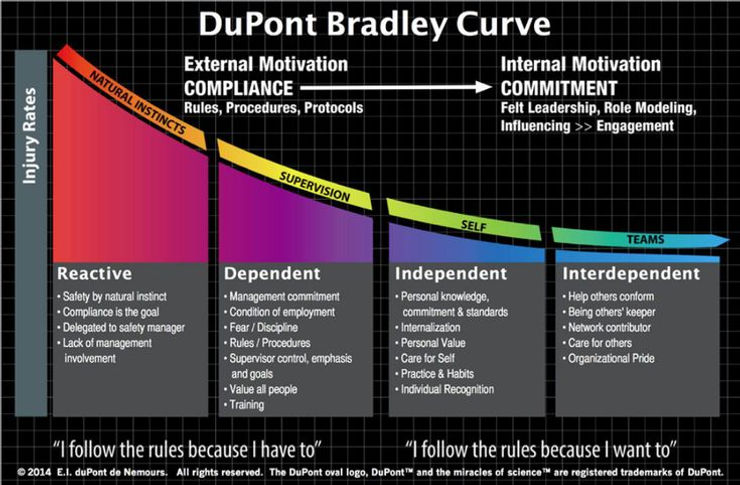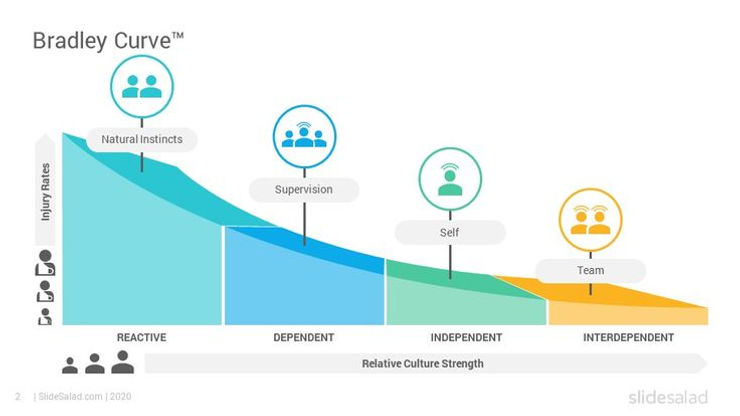The importance of a robust safety culture in occupational safety cannot be overstated. The Bradley Curve is a strategic framework to enhance safety culture within organizations, guiding them through various stages of maturity. This comprehensive guide explores the nuances of the Bradley Curve, its stages, implementation strategies, and how it can fundamentally improve workplace safety.

What is the Bradley Curve, and How Does it Relate to Safety Culture?
Understanding the Bradley Curve Framework
The Bradley Curve is a conceptual model that illustrates the evolution of an organization's safety culture. Developed by DuPont, the Bradley Curve emphasizes the relationship between an organization's culture and accident rates. It posits that as a company's safety culture matures, its commitment to safety increases, significantly reducing workplace accidents. The framework is visually represented as a curve that transitions through four stages: Reactive, Dependent, Independent, and Interdependent. Each stage reflects the level of safety culture present in the organization and highlights the necessary steps to improve safety performance.
Importance of Safety Culture in Occupational Safety
A strong safety culture is pivotal in promoting occupational safety. It encompasses the shared beliefs, practices, and attitudes that shape how safety is prioritized within the workplace. The commitment to safety at all levels of the organization is crucial for minimizing hazards and reducing the accident rate. Organizations with a robust safety culture experience fewer workplace accidents, lower insurance premiums, and enhanced employee morale. Hence, understanding and implementing the Bradley Curve becomes essential for organizations aiming to improve their safety culture effectively.
How the Bradley Curve Influences Workplace Safety
The Bradley Curve influences workplace safety by providing a structured approach to improve safety measures. As organizations progress along the Bradley Curve, they shift from a reactive stance—where safety measures are taken only after accidents occur—to a proactive approach that anticipates and mitigates risks before they lead to incidents. This proactive culture fosters an environment where employees feel empowered to prioritize safety, report hazards, and engage in safety discussions. Consequently, this cultural shift reduces accident rates and enhances overall safety performance, creating a sustainable model for occupational safety.

What are the Four Stages of the Bradley Curve?
Exploring the Reactive Stage of Safety Culture
The first stage of the Bradley Curve is the Reactive stage, characterized by a lack of proactive safety measures. OrganizationsAt this stage, organizations respond to accidents and incidents rather than prevent them. Safety protocols are often implemented only after a workplace accident occurs, leading to a culture of compliance rather than a commitment to safety. Organizations stuck in this stage typically exhibit high accident rates and poor safety culture, making it imperative to transition to the next stage to foster a healthier work environment.
Characteristics of the Proactive Stage
As organizations implement the Bradley Curve, they enter the Proactive stage of safety culture. In this stage, companies start to recognize the importance of preventing workplace accidents before they happen. Safety measures are implemented to identify potential hazards, and employees are encouraged to participate in safety training and discussions. There is a noticeable shift in the corporate culture, where the focus moves towards recognizing safety as a core value rather than just a regulatory requirement. Organizations in this stage report improved safety performance and reduced accident rates, marking a significant milestone in their journey along the Bradley Curve.
Understanding the Interdependent Stage
The Interdependent stage represents a mature safety culture where safety is embedded in the organization's core values. Employees take personal responsibility for safety in this stage and strongly emphasize teamwork and collaboration to identify and mitigate hazards. Organizations foster an environment where everyone is equally committed to improving safety outcomes, significantly reducing workplace accidents. This stage is characterized by open communication regarding safety issues, active participation in safety initiatives, and a culture of continuous improvement, reflecting the highest level of safety culture maturity.

How to Implement the Bradley Curve in Your Organization?
Steps to Implement the Bradley Curve Effectively
Implementing the Bradley Curve effectively requires a strategic approach that involves several key steps. First, organizations must thoroughly assess their current safety culture to identify which stage they are in along the Bradley Curve. This assessment should include employee surveys, safety audits, and analysis of incident reports. Once the current stage is determined, organizations can develop a tailored plan to advance through the stages. This plan should focus on enhancing safety training, improving communication regarding hazards, and promoting employee engagement in safety initiatives. Leadership commitment is crucial, as management must model the desired safety behaviours and reinforce the importance of a strong safety culture.
Challenges in Implementing the Bradley Curve
Implementing the Bradley Curve offers numerous benefits, but organizations may encounter challenges. Resistance to change is a common obstacle, as employees may be accustomed to existing safety protocols. Additionally, a lack of resources or inadequate training can hinder efforts to advance through the stages of the Bradley Curve. Organizations must be prepared to address these challenges by fostering open communication, providing necessary training, and continually emphasizing the importance of safety within the corporate culture. Recognizing and addressing these challenges is essential for successful implementation.
Measuring Success After Implementing the Bradley Curve
Measuring success after implementing the Bradley Curve involves tracking key performance indicators related to safety culture and performance. Organizations should monitor accident rates, near-miss incidents, and employee engagement in safety initiatives. Surveys can also be employed to gauge employee perceptions of safety culture and their commitment to safety practices. By regularly assessing these metrics, organizations can identify areas for improvement and celebrate successes, ensuring that the commitment to safety remains a priority as they continue to advance along the Bradley Curve.

How Does the Bradley Curve Improve Workplace Safety?
Impact of the Bradley Curve on Accident Rates
The Bradley Curve significantly impacts reducing accident rates within organizations. As companies progress from the Reactive stage to the Interdependent stage, they experience a notable decline in workplace accidents. This improvement is attributed to the enhanced focus on proactive safety measures, employee involvement, and a strong commitment to safety at all levels. By nurturing a safety culture that prioritizes prevention, organizations can effectively minimize hazards and create a safer work environment.
Enhancing Safety Performance Through the Bradley Curve
Enhancing safety performance through the Bradley Curve entails fostering a culture where safety is integrated into every aspect of the organization. This includes developing comprehensive safety training programs, encouraging employee participation in safety initiatives, and ensuring that safety protocols are regularly reviewed and updated. By engaging employees in the safety process and making safety a shared responsibility, organizations can cultivate a strong safety culture that leads to improved performance and reduced accident rates.
Real-life Examples of Improved Safety Culture Using the Bradley Curve
Numerous organizations have successfully utilized the Bradley Curve to enhance their safety culture. For instance, a manufacturing company initially operating in the Reactive stage implemented the Bradley Curve framework and focused on employee training and hazard identification. Over time, the organization transitioned to the Interdependent stage, dramatically reducing accident rates and improving employee morale. Such real-life examples illustrate the effectiveness of the Bradley Curve in fostering a strong safety culture and achieving significant improvements in workplace safety.

How Can Organizations Transition Along the Bradley Curve?
Strategies for Moving from Reactive to Proactive Safety Culture
Organizations transitioning from a Reactive to a Proactive safety culture must implement targeted strategies that promote safety awareness and engagement. One effective strategy is establishing safety committees that empower employees to participate in safety discussions and decision-making processes. Regular safety training sessions can also be conducted to equip employees with the knowledge and skills necessary to identify hazards and implement preventive measures. Additionally, recognizing and rewarding employees for their contributions to safety can reinforce a proactive mindset across the organization.
Identifying Key Indicators of Progress Along the Bradley Curve
Identifying key progress indicators along the Bradley Curve is essential for organizations to assess their advancement through the stages. Metrics such as the frequency of safety audits, employee participation rates in safety training, and reported near-misses can serve as valuable progress indicators. Organizations should also track changes in employee perceptions of safety culture through surveys, providing insight into how well safety initiatives are being received and whether the desired cultural changes are occurring.
Fostering an Interdependent Safety Culture
Organizations must build strong relationships among employees, management, and safety personnel to foster an Interdependent safety culture. This can be achieved by promoting open communication channels where safety concerns can be discussed freely and collaboratively. Encouraging teamwork in safety initiatives helps reinforce the idea that safety is a collective responsibility. Organizations should also invest in continuous improvement opportunities, ensuring that safety remains a dynamic aspect of the corporate culture. By nurturing a sense of shared responsibility, organizations can solidify their commitment to safety and enhance overall safety performance.https://nextworldxr.com/
It is important to consult a safety professional before undertaking any of the steps outlined in this article
Author:
Share Article:
Author:
Share Article:

